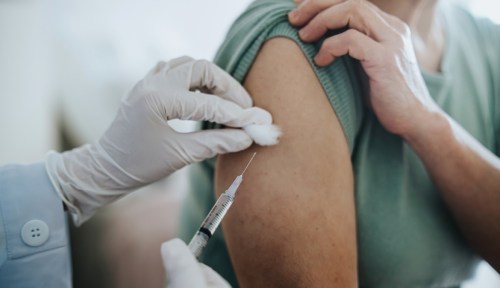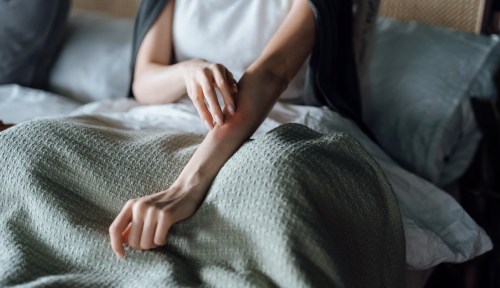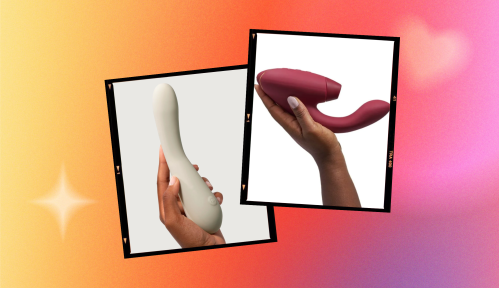For many people with a uterus, period cramps are par for the course just about every month (ugh, I know). But if you get cramps when you’re not on your period, you might be scratching your head, either totally confused or concerned. The good news? These pelvic cramps aren’t usually serious.
Experts in This Article
board-certified OB/GYN and assistant professor at the Raquel and Jaime Gilinski department of obstetrics, gynecology, and reproductive science at Icahn School of Medicine at Mount Sinai
“Pelvic cramping without a period can happen due to ‘normal’ or physiologic changes,” says Susan S. Khalil, MD, board-certified OB/GYN and assistant professor in the Raquel and Jaime Gilinski department of obstetrics, gynecology, and reproductive science at the Icahn School of Medicine at Mount Sinai. Still, sometimes period-like symptoms without bleeding can also be related to certain health conditions.
Read on to learn why you may get cramps but no period, how to ease the pain, and when you should see a doctor about non-period-related cramping.
1. It’s a sign of early pregnancy
Before a successful pregnancy can happen, a fertilized egg (i.e., embryo) needs to implant in your uterus. In other words, the egg has to securely attach itself to the lining of your womb, so it can make its home there and grow for the subsequent 40 or so weeks. As the egg burrows deep into your uterine lining (called the endometrium), this can cause some slight cramping (and sometimes spotting, too), according to Nemours Children’s Health.
Just keep in mind: Not everyone will have cramping as an early pregnancy sign, and not every cramp without a period means you’re pregnant. Every body is different! If you’re unsure whether you’re pregnant, take an at-home pregnancy test and/or schedule an appointment with your OB/GYN.
What’s the difference between period cramps and early pregnancy cramps?
Sometimes it’s tough to tell the difference between period cramps and early pregnancy cramps. Not only do they feel similar, but they also usually happen around the same time of the month (i.e., around the time when your period is supposed to come). Adding to the confusion, some people also get nausea, headaches, tiredness, sore breasts, and dizziness during the first days of their period, but these symptoms can also be pretty common when you’re in the early days of pregnancy, too.
While both kinds of cramps can feel the same, there are some subtle differences. For one, “period cramps have a different [physiological] cause than early pregnancy cramps,” Dr. Khalil says. Period cramps happen when your body releases prostaglandins, which make your uterus contract so it can shed its lining (i.e., period blood). On the other hand, early pregnancy cramps are often due to implantation. As we learned, when the embryo implants in the uterus, it burrows deep into the endometrium, which can cause some slight cramping.
There are also other ways to distinguish period cramps from implantation cramps. Here are some clues, according to RMC Health System:
- The severity of your cramps: Implantation cramps are usually less intense than menstrual cramps.
- A missed period: If your period is late or nonexistent (when it’s usually right on time), and you have slight cramping, it can be an early pregnancy sign.
- The amount of bleeding: Implantation can cause some spotting, but it’s typically not as heavy as a period flow.
2. You’re ovulating
If you notice a pattern of pelvic cramping that happens in the middle of your menstrual cycle (think: the 14th day if you have a 28-day cycle), it might be linked to ovulation. Ovulation happens when your ovary releases an egg, and pelvic pain or cramping around this time is pretty common. Matter of fact, there’s a name for ovulation-related pain: mittelschmerz, per the Cleveland Clinic.
You may get ovulation pain if an egg ruptures from a follicle (i.e., the sacs in your ovaries that hold eggs), according to the Cleveland Clinic. This may lead to pain in your lower abdomen and pelvis—either in the middle or on one side.
Other possible signs you might be ovulating include the following, per the Cleveland Clinic:
- Vaginal discharge that’s jelly-like, clear, and slippery (like egg whites)
- Tender breasts
- Bloating
- Light bleeding or spotting
- Changes in the position and firmness of your cervix
- Increased sex drive
- Heightened sense of smell, taste, or sight
- Mood changes
- Appetite changes
If you’re unsure when you ovulate (and would like to know), you can use a period or ovulation tracking app, or keep notes in your phone or on a calendar about how you’re feeling each day of the month, to help you better understand your menstrual cycle.
3. It’s a symptom of PMS
Do your cramps tend to come right before your period starts? You might be dealing with premenstrual syndrome (PMS). More than 90 percent of people with uteruses get some sort of pre-period symptoms—cramps being one of them, according to the Office on Women’s Health.
PMS—a combination of physical and mental symptoms—happens after you ovulate and before you get your period. During this part of your menstrual cycle, some major hormonal shifts happen in your body. In the days after ovulation, estrogen and progesterone levels plummet (if you’re not pregnant), and this can lead to some pretty uncomfortable symptoms like cramping, according to the Office on Women’s Health.
Again, every person with a uterus is different. Some have severe PMS while others have less of an issue. Symptoms can also fluctuate throughout your lifetime—getting worse or better as you age.
On top of cramping, other physical symptoms of PMS can include the following, per the Office on Women’s Health:
- Swollen or tender breasts
- Constipation or diarrhea
- Bloating or a gassy feeling
- Headache or backache
- Clumsiness
- Lower tolerance for noise or light
And emotional or mental symptoms of PMS can include the following, per the Office on Women’s Health:
- Irritability or hostile behavior
- Feeling tired
- Sleep problems (sleeping too much or too little)
- Appetite changes or food cravings
- Trouble with concentration or memory
- Tension or anxiety
- Depression, feelings of sadness, or crying spells
- Mood swings
- Less interest in sex
PMS can be eased with lifestyle changes like eating a balanced diet, getting regular exercise, sleeping well, and reducing stress. Pain and discomfort can be relieved with OTC pain medications, heating pads, or even a hot bath.
4. You’re entering menopause
On the other end of the spectrum, you might get pelvic cramping as you near the end of your reproductive years. Perimenopause—the time of transition leading up to menopause, or the end of menstruation—can cause some uncomfy cramps whether you have your period or not. You can thank your hormones for this one.
Because your hormones are in flux during perimenopause, your ovulation can be irregular, too. In a typical menstrual cycle, estrogen levels dip once you’ve ovulated. But during perimenopause, your estrogen levels may stay sky high after ovulation, according to the Cleveland Clinic. When this happens, your body releases chemicals called prostaglandins, which trigger your uterus to contract. These contractions can cause cramps, sometimes without any bleeding.
Perimenopause most often starts between the ages of 40 and 44, according to Mount Sinai, although it can sometimes begin earlier, in your 30s. Other symptoms of perimenopause can include hot flashes (a sudden and intense burst of body heat) and mood changes.
5. You’re constipated
Feeling a bit backed up? Constipation is another culprit behind pelvic cramping. If you’re feeling sharp pains in your lower abdominal area, it can be from trapped gas or stool. Other telltale signs of constipation include the following, per Johns Hopkins Medicine:
- Feeling bloated
- Feeling full
- Your abdomen is visibly distended
You’re likely constipated if you’ve had fewer than three bowel movements in a week and/or your stools are hard and difficult to pass. Common causes of constipation include not drinking enough fluids or eating enough fiber, lack of exercise, holding your poop, and taking certain medications. You’re also more prone to constipation when you’re pregnant or traveling.
To get poop flowing (and to ease those cramps), try tried-and-true natural remedies for constipation like filling up on fiber-rich foods, drinking plenty of water, and making sure you’re moving around each day—like going for a walk or hitting the gym.
6. You just started a hormonal birth control
For many people, hormonal birth control can help control period cramps. That’s because it reduces your body’s release of prostaglandins (i.e., the chemicals that make your uterine muscles contract), according to Nemour Children’s Health. Fewer contractions equals fewer cramps. But when you first start certain forms of birth control, they can sometimes produce a little pelvic pain as your body adjusts.
For example, hormonal intrauterine devices (IUDs) like Mirena, Kyleena, Liletta, and Skyla can cause cramping (or backaches) for a short time after they’re inserted, per Planned Parenthood. These side effects typically go away in a few months as your uterus adjusts to the IUD.
You may also stop bleeding altogether with an IUD but still get cramps around the typical time of your period, which is sometimes called ghost periods or phantom periods.
7. You have endometriosis or adenomyosis
Pelvic pain is also common in people with endometriosis or adenomyosis, says Dr. Khalil. Endometriosis happens when endometrial-like tissue (i.e., tissue similar to the lining of your uterus) grows on other organs or parts of your body. Adenomyosis is a similar condition where the tissue lining of your uterus grows into the muscular wall of the uterus, per the Mayo Clinic.
Because this tissue is sensitive to hormonal fluctuations, it can become inflamed during different times in your menstrual cycle, according to the Cleveland Clinic. That means painful cramping can happen when you have your period or even when you don’t. With these conditions, chemical mediators (i.e., natural chemicals in your body) may alter how pain is perceived (read: it can feel more intense) and produce painful muscular changes, Dr. Khalil says.
Treatment options for adenomyosis or endometriosis cramps include pain relievers, hormonal birth control, or surgery to remove tissue, per the Cleveland Clinic.
8. You have inflammatory bowel disease
We already know the occasional bout of constipation can cause pelvic cramps. But chronic gut issues can cause pelvic pain, too. For example, people with inflammatory bowel disease (IBD) like ulcerative colitis or Crohn’s disease have ongoing inflammation in their intestines. Abdominal pain and cramping are just some of the symptoms they may deal with daily or during flare-ups.
Other signs of Crohn’s disease and ulcerative colitis include the following, per the Mayo Clinic:
- Diarrhea
- Fatigue
- Blood in your stool
- Reduced appetite
- Unintended weight loss
While Crohn’s disease and ulcerative colitis cannot be cured, they can be managed with things like anti-inflammatory drugs, immunosuppressants, or biologics (meds that help reduce inflammation), per the Mayo Clinic.
9. It’s an infection
Cramping without a period can also be a sign of an infection. Some common infections that can cause pelvic cramps include:
Pelvic inflammatory disease (PID)
This is a potentially serious bacterial infection that affects your uterus, fallopian tubes, and/or ovaries. It’s usually caused by an untreated sexually transmitted infection (STI). Along with pelvic pain, you might also have other symptoms like the following, per the Cleveland Clinic:
- Pain or tenderness in your stomach or lower abdomen
- Abnormal vaginal discharge, usually yellow or green with an unusual odor
- Chills or fever
- Nausea and vomiting
- Pain during sex
- Irregular periods or spotting and/or cramping throughout the month
Urinary tract infection (UTI)
A UTI happens when bacteria enter the urethra (i.e., your pee tube) and infect the urinary tract. The most common kind of UTI is a bladder infection. On top of cramping (or pressure) in the groin or lower abdomen, you may have other symptoms like the following, per the Centers for Disease Control and Prevention (CDC):
- Pain or burning while urinating
- Frequent urination
- Feeling the need to urinate despite having an empty bladder
- Bloody urine
Left untreated, PID (and sometimes UTIs) can lead to more serious health problems, like ectopic pregnancy or infertility, per the Mayo Clinic. If you suspect your pelvic pain is related to an infection, see your doctor. You’ll likely need an antibiotic to cure it and prevent complications.
10. You have fibroids or polyps
Abnormal growths in the uterus—called fibroids and polyps—can also cause pelvic cramping.
When uterine fibroids (made of muscle and tissue) are small, they’re usually no big deal. But when they grow larger, they can be uncomfortable. You might even feel pain during sex or low-back pain, as well, according to the Cleveland Clinic.
Pelvic pain isn’t a telltale sign of uterine polyps (made of endometrial tissue), but if they get big enough, they can cause a dull, aching feeling in your belly or lower back like menstrual cramps, per the Cleveland Clinic.
Both conditions can also cause irregular periods and spotting, among other annoying symptoms. While both are often harmless and can be left alone, your doctor may recommend getting them surgically removed if they’re causing pain, or you’re bleeding after menopause (which can be a potential precursor to cancer).
11. You have an ovarian cyst
Ovarian cysts are fluid-filled sacs that grow on or inside your ovaries—the organs that hold your egg cells. They’re super common, typically harmless, and often go away on their own. While most people won’t even know they have an ovarian cyst, others might have pelvic pain or a dull ache in their back if the cysts become big enough, according to the Cleveland Clinic. Depending on the person, this pelvic pain can be sharp or dull and come and go for no reason.
Other symptoms you may feel with an ovarian cyst include the following, per the Cleveland Clinic:
- A feeling of fullness (bloating) in your lower stomach that may feel more pronounced on one side of your body
- Pain during sex (called dyspareunia)
- Painful periods
While most ovarian cysts will burst or shrink on their own, some may need to be surgically removed. Your doctor can determine this by taking an ultrasound of your ovaries.
12. You have polycystic ovary syndrome (PCOS)
Polycystic ovary syndrome (PCOS) happens when your ovaries produce too many hormones called androgens, which creates a hormonal imbalance. People with PCOS often have multiple cysts on their ovaries and accompanying pelvic pain.
Other possible signs of PCOS to look out for are the following, per the National Library of Medicine:
- Irregular menstrual periods
- Infertility
- Excess hair growth on the face, chest, stomach, or thighs
- Weight gain
- Acne or oily skin
- Patches of thickened skin
While PCOS cannot be cured, there are lifestyle changes you can make to manage the condition, including eating a balanced diet, exercising, practicing stress relief, and taking certain vitamins, supplements, or medications prescribed by your doctor, per the World Health Organization.
13. You recently had a hysterectomy
Many people choose to have a hysterectomy (an operation to remove the uterus) to relieve issues that cause chronic pelvic pain, like endometriosis or uterine fibroids. It can also be part of a treatment plan for certain gynecologic cancers. Because it’s a pretty involved surgery—recovery can take up to eight weeks—you may have some initial cramping and discomfort in your pelvic area as you recover. You might also get constipation and vaginal bleeding as your muscles heal, according to the National Health Service (NHS). And if your ovaries are still intact, you can still ovulate and feel ovulation pain despite no longer having a period.
Keep checking in with your doctor and going to follow-up appointments after you’ve had a hysterectomy, to make sure you are healing properly.
14. You have interstitial cystitis
Interstitial cystitis (IC), also known as painful bladder syndrome, is a chronic condition that happens when your bladder wall becomes inflamed or irritated. It can feel a lot like recurring UTIs, as symptoms are very similar, including feelings of pressure, pain, and tenderness around the bladder, pelvis, and the area between the anus and vagina (perineum), according to Johns Hopkins Medicine.
According to Johns Hopkins Medicine, other possible IC symptoms are:
- Frequent urination
- Urgency with urination
- Pain during sex
These symptoms may get worse around your period or when you’re feeling super stressed. Even certain foods (like spicy or acidic foods) can trigger an IC flare-up.
While it can be tricky to diagnose, IC can be identified and managed with help from a urologist. Treatment usually includes things like avoiding triggers, training your bladder (to urinate at specific times), or taking medication (by mouth or injected directly into your bladder), per Johns Hopkins Medicine.
Treatment for cramps without a period
While pelvic cramping is no fun, there are ways to make it hurt (and suck) less. Here are some tips to manage pelvic pain at home, according to the Cleveland Clinic:
- Take over-the-counter pain relievers: These can help reduce swelling and ease pain.
- Make time for exercise: It can help increase blood flow and may help reduce your discomfort.
- Apply heat: Place a heating pad or warm compress over your pelvic area, or take a long soak in a hot bath to relieve pain and relax tense muscles.
- Quit smoking: Tobacco products can inflame nerves and cause pain.
- Practice relaxation exercises: Yoga, mindfulness, or meditation can help reduce stress and tension in the body, which can worsen pain.
Because pelvic pain or cramping can be a symptom of another underlying health issue, it’s also essential that you first treat the root cause. As you start treating the underlying health concern, your pain may subside or even go away.
When to see a doctor
While cramping and pelvic pain outside of your period can be totally normal, it can also be your body’s warning sign that something else is going on. “If pelvic cramping is so severe or disruptive that it interrupts activities of daily living, it’s critical to see a health-care provider to evaluate,” says Dr. Khalil.
Likewise, if you have the following symptoms along with cramps, get medical care right away, per the Cleveland Clinic:
- Pelvic pain that’s sharp, severe, or sudden
- You’re unable to stand up straight
- There’s blood in your urine or stool
- You’re running a fever
- You’re pregnant or have been pregnant in the last six months
FAQ
What are other menopause symptoms?
Hot flashes, night sweats, low libido—everyone’s heard of these menopause symptoms. But as we learned, people going through menopause can feel other things, too, like pelvic cramping. While every menopausal person is different, here some of the most common signs that you’re in the middle of this midlife transition, per the Mayo Clinic:
- Irregular periods
- Vaginal dryness
- Hot flashes
- Chills
- Night sweats
- Sleep problems
- Mood changes
- Weight gain and slowed metabolism
- Thinning hair and dry skin
- Loss of breast fullness
Talk to your doctor if your menopause symptoms are disrupting your daily life. They can suggest treatments like hormone therapy and other lifestyle changes.
What’s the best way to treat period cramps at home?
Painful periods are not fun. But you don’t need to suffer through. Try these strategies to soothe period cramps, per the Cleveland Clinic:
- Take NSAIDs and other pain relievers (only if you’re fairly sure you’re not pregnant)
- Try hormonal birth control (people who take hormonal medications tend to have less menstrual pain)
- Use a heating pad or hot water bottle on your lower back or abdomen when you have cramps
- Get extra rest
- Avoid foods and drinks that have caffeine
- Avoid smoking cigarettes and drinking alcohol
- Massage your lower back and abdomen
- Exercise regularly
- Try yoga
- Try acupuncture or acupressure
- Incorporate relaxation or breathing exercises
- Eat anti-inflammatory foods like leafy green vegetables, ginger, and nuts, or drink green tea
- Treat any underlying conditions causing you pain
Is it normal to not have period cramps?
Yep, “it is normal not to have period cramps,” Dr. Khalil says. While menstrual cramps are common (60 percent of people with a uterus get light period cramps, per the Cleveland Clinic), many others don’t ever get period-related pain. Once again, every person’s body is unique, so the symptoms (or lack thereof) you get during your period will be, too. The takeaway? If you’ve never had period cramps, consider yourself lucky!
—medically reviewed by Andrea Braden, MD, OB/GYN
Sign Up for Our Daily Newsletter
Get all the latest in wellness, trends, food, fitness, beauty, and more delivered right to your inbox.
Got it, you've been added to our email list.











